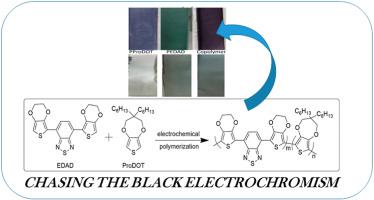Our official English website, www.x-mol.net, welcomes your
feedback! (Note: you will need to create a separate account there.)
Chasing the black electrochromism: A new electrochromic copolymer based on 4,7-bis(2,3-dihydrothieno[3,4-b][1,4]dioxin-5-yl)benzo[c][1,2,5]thiadiazole and ProDOT
Polymer ( IF 4.1 ) Pub Date : 2022-08-20 , DOI: 10.1016/j.polymer.2022.125250 Emine Gül Cansu Ergun , Buket Bezgin Carbas
Polymer ( IF 4.1 ) Pub Date : 2022-08-20 , DOI: 10.1016/j.polymer.2022.125250 Emine Gül Cansu Ergun , Buket Bezgin Carbas

|
Absorbing all the visible light, in other words, neutral state black electrochromics has a great importance for certain applications such as smart windows, electronic papers, car rear views or displays. In this study, it was focused on a combination of monomers that can absorb entire the visible region. Poly(4,7-bis(2,3-dihydrothieno[3,4-b][1,4]dioxin-5-yl)benzo[c][1,2,5]thiadiazole) (PEDAD) is a neutral state green polymer and has a dual absorption band before and after 500 nm, corresponding red and blue regions of the visible spectrum. On the other hand, polymer of dihexyl-3,4-propylenedioxythiphene (PProDOT) has an 400–700 nm optical absorption band with having a maximum at 584 nm. In the light of this information, a new copolymer, consisting of 4,7-bis(2,3-dihydrothieno[3,4-b][1,4]dioxin-5-yl)benzo[c][1,2,5]thiadiazole and ProDOT, was synthesized via electrochemical techniques, to trap the entire visible region. 1:1 eq. of monomer feed was used and a neutral state very-dark copolymer was obtained. The copolymer showed enhanced optical contrast coming from PProDOT, (of having 44% transmittance) and lower band gap coming from PEDAD (of having 1.32 eV). In the oxidized state, the copolymer exhibited transmissive blue, coming from both homopolymers.
中文翻译:

追逐黑色电致变色:基于4,7-双(2,3-二氢噻吩并[3,4-b][1,4]二恶英-5-基)苯并[c][1,2,5]的新型电致变色共聚物]噻二唑和 ProDOT
吸收所有可见光,换句话说,中性态黑色电致变色材料对于智能车窗、电子纸、汽车后视或显示器等某些应用非常重要。在这项研究中,重点关注可以吸收整个可见光区域的单体组合。聚(4,7-双(2,3-二氢噻吩并[3,4-b][1,4]二恶英-5-基)苯并[c][1,2,5]噻二唑) (PEDAD) 是一种中性物质状态为绿色聚合物,在500 nm前后具有双吸收带,对应可见光谱的红色和蓝色区域。另一方面,二己基-3,4-丙二氧基噻吩(PProDOT)的聚合物具有400-700 nm的光学吸收带,最大值在584 nm。根据这一信息,一种新的共聚物由 4,7-双(2,3-二氢噻吩并[3,4-b][1,4]二恶英-5-基)苯并[c][1,2 ,5]噻二唑和 ProDOT 通过电化学技术合成,以捕获整个可见区域。 1:1 当量使用单体进料并获得中性状态的非常暗的共聚物。该共聚物表现出来自 PProDOT 的增强光学对比度(具有 44% 的透射率)和来自 PEDAD 的较低带隙(具有 1.32 eV)。在氧化状态下,该共聚物呈现出来自两种均聚物的透射蓝色。
更新日期:2022-08-20
中文翻译:

追逐黑色电致变色:基于4,7-双(2,3-二氢噻吩并[3,4-b][1,4]二恶英-5-基)苯并[c][1,2,5]的新型电致变色共聚物]噻二唑和 ProDOT
吸收所有可见光,换句话说,中性态黑色电致变色材料对于智能车窗、电子纸、汽车后视或显示器等某些应用非常重要。在这项研究中,重点关注可以吸收整个可见光区域的单体组合。聚(4,7-双(2,3-二氢噻吩并[3,4-b][1,4]二恶英-5-基)苯并[c][1,2,5]噻二唑) (PEDAD) 是一种中性物质状态为绿色聚合物,在500 nm前后具有双吸收带,对应可见光谱的红色和蓝色区域。另一方面,二己基-3,4-丙二氧基噻吩(PProDOT)的聚合物具有400-700 nm的光学吸收带,最大值在584 nm。根据这一信息,一种新的共聚物由 4,7-双(2,3-二氢噻吩并[3,4-b][1,4]二恶英-5-基)苯并[c][1,2 ,5]噻二唑和 ProDOT 通过电化学技术合成,以捕获整个可见区域。 1:1 当量使用单体进料并获得中性状态的非常暗的共聚物。该共聚物表现出来自 PProDOT 的增强光学对比度(具有 44% 的透射率)和来自 PEDAD 的较低带隙(具有 1.32 eV)。在氧化状态下,该共聚物呈现出来自两种均聚物的透射蓝色。






























 京公网安备 11010802027423号
京公网安备 11010802027423号